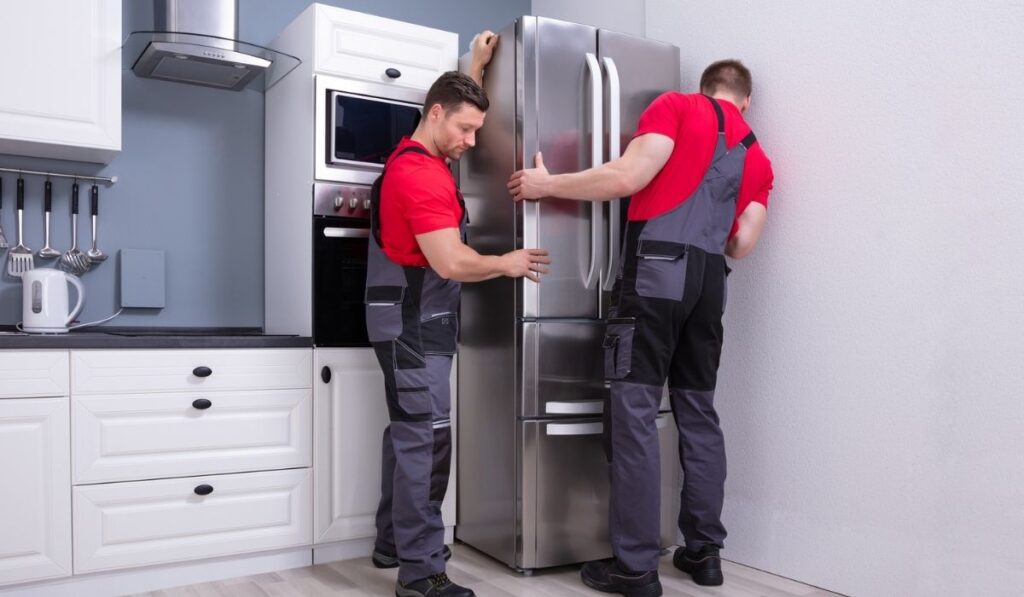Whether you need to relocate your fridge or take it in for repairs, transporting such a large appliance can be a tedious and challenging task. Sometimes, after transport, you might notice that your refrigerator isn’t working as well as it used to. Many people say this issue is the result of transporting the fridge in the wrong position. Is this true?
You can usually transport a fridge on its side or back if necessary, but you can easily damage it if you aren’t careful. Always watch out for the compressor tube and oil, secure the doors, and wait about 24 hours before you turn on the fridge in its new location.
As you prepare to move your fridge, there are a few factors to keep in mind. As long as you proceed carefully, you should be able to get this task done safely and without causing any damage. Let’s take a look at the full process so that you’re ready to go.
What You Need to Know About Transporting a Fridge on Its Side or Back

Many refrigerator manufacturers advise against moving a refrigerator on its side or back. However, if you can’t move the fridge upright, here are some things you need to know.
Be Aware of the Compressor Tube
The first thing is that the oil from the compressor flows into the coolant line when you carry the refrigerator on its side. When this happens, the oil clogs the coolant lines leading to problems with the fridge along the line.
The next factor to consider is the side the fridge is transported on. For example, if the side with the compressor tube faces downwards, there’s a higher chance of the oil leaking away. To prevent this, ensure that the side with the compressor tube is facing upwards.
If the compressor oil enters the suction pipe, there’s nothing to worry about. The reason for this is that the compressor will suck it right back when it starts working again.
However, if the oil gets into the discharge pipe, the compressor will push the oil through the whole refrigerating system. When that happens, it can cause other problems within the refrigerator.
Usually, when the refrigerator is back in its proper position for at least twenty-four hours, everything returns to normal.
The compressor is connected to two pipes, the suction (that sucks the refrigerant) and the discharge (the pipe that takes the compressed refrigerant into the fridge). Since most refrigerator manufacturers don’t label the discharge pipe and the suction pipe, the best thing is to lay the fridge on the side where the oil stays in the compressor.
If you are willing to guess, the pipe with the minor diameter is the discharge pipe in most cases. The difference isn’t much, but you should be able to tell. When you find that pipe, lay your fridge on the opposite side of that pipe.
Secure the Fridge Door
Apart from looking out for compressor oil and discharge pipe, it would help if you also secure the fridge door. Depending on the side of the fridge facing down, the door can fall open if it’s not adequately secured.
Using electrical tape is a great way to hold the door in place. It doesn’t peel the fridge paint, unlike duct tape.
Watch Out for the Compressor’s Spring Mounts
The last item you should look out for is the compressor’s spring mounts. Usually, about three to four spring mounts hold the compressor in place. It’s pretty rare for them to get damaged during transportation, as they designed the mounts to cope with up and down movement.
However, a freak accident can cause a jolt or a snap in the mounts. The result of damaged compressor mounts is either a noisy compressor or a damaged compressor.
How to Prepare Your Refrigerator for Moving
To prevent any damage to your refrigerator, there are some things you should do before your refrigerator even gets on the moving truck at all. Here are ways to prepare your refrigerator when you want to move:
Unplug Your Refrigerator
Though this suggestion seems obvious, you’ll be surprised by how many people forget to do this. Removing your refrigerator from the power source is not only for your safety. It helps to minimize any damage to the fridge during transportation.
After unplugging the fridge, another thing you should do is to secure the plug. You don’t want the plug dragging on the floor or being susceptible to damage. If the cord is long enough, fold and hang it so that it doesn’t hamper the movement of those carrying the fridge.
Empty Your Refrigerator
Now that your refrigerator cord and plug are secure, the next step is to empty your fridge. Emptying your refrigerator has many advantages. One of them is making your refrigerator lighter. A full fridge can be heavy to move. Emptying it of its contents eases carrying.
Another reason you need to empty your fridge is that perishable products will likely go bad during and after moving. Remember to turn off your refrigerator for a while before moving. You also have to leave it off for about twenty-four hours after transit. That’s enough time for any food to go bad.
Bottles and cans are the most dangerous things you leave in the fridge while transporting. Bottles rattling against each other while moving can break and cause damage to those carrying the refrigerator or the refrigerator itself. The same thing can happen with cans.
You might think you are saving space by keeping things in your fridge, but the cons for doing that outweigh the pros.
Defrost Your Refrigerator
Defrosting your fridge saves you the stress of having melting ice dripping everywhere and messing everything up while you move. The ideal thing is to allow all the ice to melt before moving. If you are planning to transport your refrigerator in the morning, turn it off the previous night and let it defrost.
When you’re confident that all the ice is gone, clear away the excess water. Ensure the fridge’s interior is dry, and clean all exterior places where melted ice is dripping. You need to clean the excess water to avoid leaking and prevent water from entering parts of the refrigerator. It can cause damage.
Remove All the Shelves
Your refrigerator’s contents aren’t the only thing you need to remove. The shelves inside need to go as well. You might think it’s not necessary, or it’s too much work, but the alternative might cost you hundreds of dollars.
The shelves can slip from their position while the refrigerator is in transit. When this happens, not only will the shelves break, but the broken parts might damage the fridge’s features.
It’s better to be safe than sorry, so remove the shelves, store them somewhere else safely, and transport the refrigerator empty.
Strap the Fridge Door Shut
The next step is to strap the refrigerator doors shut. If you don’t do that, they might open during transit and cause some damage to other things in the truck or get damaged themselves. Tape the doors shut, and you are good to go.
How to Safely Transport Your Refrigerator
You have prepared your refrigerator for transport, now here’s how you can safely transport it to its new location:
Carefully Load the Refrigerator on the Truck
The other steps you can probably do on your own, but with this step, you’ll need help. You might think an empty fridge would be easy to carry single-handed, but you would be wrong.
While struggling with the refrigerator, you could drop it and damage it.
The best thing is to find someone to help, carefully carry the refrigerator to the truck, and load it. The best position for the fridge is for it to stay upright. If space constraints don’t allow that, then put it on the side.
We have already discussed precautions to take when placing the refrigerator on its side. We should also state that you cannot place all refrigerators on their side.
Some refrigerators have to be transported upright, such as those with French doors and a freezer on the bottom. The manufacturers usually specify the best position to transport their products, so follow their instructions.
Secure the Refrigerator on the Truck
Loading the refrigerator on the moving truck isn’t the end of the job. You still have to make sure it’s properly secured. Make sure that the fridge can’t move while the vehicle is in motion.
You can use ropes to hold the refrigerator in place or use other objects to secure it.
When Can I Turn the Fridge Back On?

If you transported your refrigerator lying down, the best thing to do is let it settle before turning it on. The reason is simple: Moving the compressor while the fridge is lying down means that the compressor oil would have certainly moved around the pipes.
It is best to let the oil settle back into the compressor before turning the refrigerator on. If you don’t, it will affect the refrigerator’s cooling or even damage the fridge.
In order to determine how long you need to wait before turning on your fridge, check the refrigerator’s manual or contact the manufacturer. On average, though, the waiting time is about twenty-four hours. If the manual or the manufacturer says something different, follow their advice.
Apart from ensuring that the compressor oil returns into the compressor before turning it on, you also have to inspect the refrigerator to ensure there’s no damage to any parts.
Even if you aren’t a technician, inspecting a broken pipe or a damaged compressor mount doesn’t require expertise. If you notice any damage, get a technician before powering your refrigerator.
Conclusion
Transporting your refrigerator is a delicate business. You have to handle every stage with care so that your refrigerator will be in the same condition as it was before you moved it. You can lay your fridge down when you transport it, but you have to be careful.
Unless you transport your refrigerator in an upright position, don’t switch it on immediately after transporting. Be careful to make sure the compressor pipes aren’t damaged while transporting.
Furthermore, before moving the refrigerator, follow the tips to ensure that nothing happens to the refrigerator parts or its interior and exterior.
Finally, as we mentioned, not all refrigerators can be transported lying down. Refrigerators with French doors and monogram refrigerators have to be transported upright no matter what.
